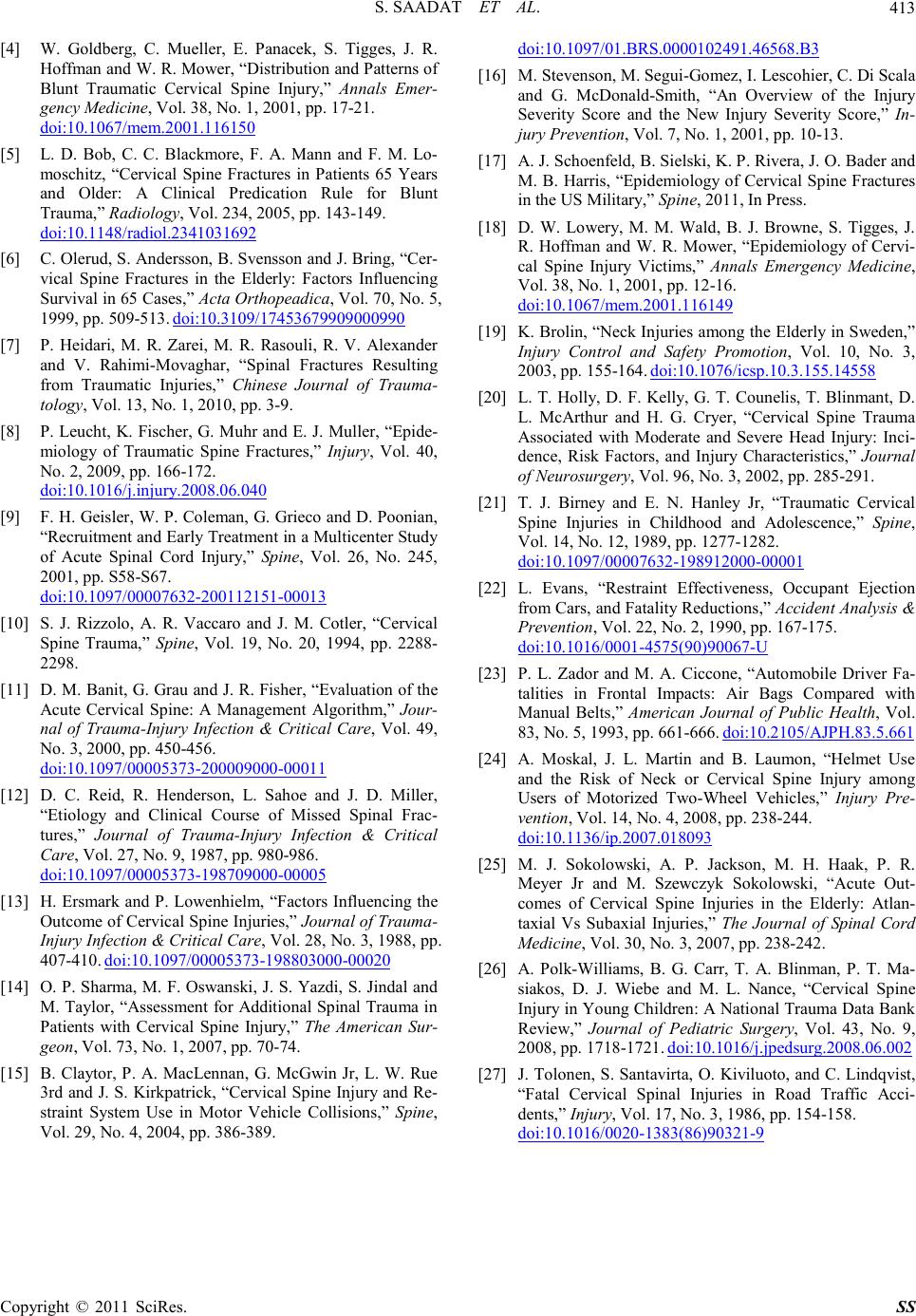
S. SAADAT ET AL.
Copyright © 2011 SciRes. SS
413
[4] W. Goldberg, C. Mueller, E. Panacek, S. Tigges, J. R.
Hoffman and W. R. Mower, “Distribution and Patterns of
Blunt Traumatic Cervical Spine Injury,” Annals Emer-
gency Medicine, Vol. 38, No. 1, 2 001 , pp. 17- 21 .
doi:10.1067/mem.2001.116150
[5] L. D. Bob, C. C. Blackmore, F. A. Mann and F. M. Lo-
moschitz, “Cervical Spine Fractures in Patients 65 Years
and Older: A Clinical Predication Rule for Blunt
Trauma,” Radiology, V ol. 23 4, 2 005, pp. 143-1 49.
doi:10.1148/radiol.2341031692
[6] C. Olerud, S. Andersson, B. Svensson and J. Bring, “Cer-
vical Spine Fractures in the Elderly: Factors Influencing
Survival in 65 Cases,” Acta Orthopeadica, Vol. 7 0 , N o . 5,
1999, pp . 509-513. doi:10.3109/17453679909000990
[7] P. Heidari, M. R. Zarei, M. R. Rasouli, R. V. Alexander
and V. Rahimi-Movaghar, “Spinal Fractures Resulting
from Traumatic Injuries,” Chinese Journal of Trauma-
tology, Vol. 13, No. 1, 20 10, pp. 3-9.
[8] P. Leucht, K. Fischer, G. Muhr and E. J. Muller, “Epide-
miology of Traumatic Spine Fractures,” Injury, Vol. 40,
No. 2, 2009, pp. 166-172.
doi:10.1016/j.injury.2008.06.040
[9] F. H. Geisler, W. P. Coleman, G. Grieco and D. Poonian,
“Recruitmen t and E arly Treatmen t in a Multi center Study
of Acute Spinal Cord Injury,” Spine, Vol. 26, No. 245,
2001, pp. S 58- S 6 7.
do i:10.1097 /00007632-20 0112151-00013
[10] S. J. Rizzolo, A. R. Vaccaro and J. M. Cotler, “Cervical
Spine Trauma,” Spine, Vol. 19, No. 20, 1994, pp. 2288-
2298.
[11] D. M. Banit, G. Grau and J. R. Fisher, “Evaluation of the
Acute Cervical Spine: A Management Algorithm,” Jour-
nal of Trauma-Injury Infection & Critical Care, Vol. 49,
No. 3, 2000, pp. 450-456.
do i:10.1097 /00005373-20 0009000-00011
[12] D. C. Reid, R. Henderson, L. Sahoe and J. D. Miller,
“Etiology and Clinical Course of Missed Spinal Frac-
tures,” Journal of Trauma-Injury Infection & Critical
Care, Vol. 27, No. 9, 1987, pp. 980-986.
do i:10.1097 /00005373-19 8709000-00005
[13] H. Ersmark and P. Lowenhielm, “Factors Influencing the
Outcome of Cervic al Spi ne Injuries,” Journal of Trauma-
Injury Infection & Critical Care, Vo l. 28 , No. 3, 1988 , pp .
407-410. doi:10.1097/00005373-198803000-00020
[14] O. P. Sharma, M. F. Oswanski, J . S. Yazdi, S. Jind al and
M. Taylor, “Assessment for Additional Spinal Trauma in
Patients with Cervical Spine Injury,” The American Sur-
geon, Vol. 73, No. 1, 2007, pp. 70-74.
[15] B. Claytor, P. A. MacLennan, G. McGwin Jr, L. W. Rue
3rd and J. S. Kirkp atrick, “Cervical Spi ne Injury and Re-
straint System Use in Motor Vehicle Collisions,” Spine,
Vol. 29, No. 4, 2004, pp. 386-389.
do i:10.1097/01 .BRS.0000102491.46568. B3
[16] M. Stevenson, M. Segui-Gomez, I. Lescohier, C. Di Scala
and G. McDonald-Smith, “An Overview of the Injury
Severity Score and the New Injury Severity Score,” In-
jury Prevention, Vol. 7, No. 1, 2001, pp. 10-13.
[17] A. J. Schoenfeld, B. Sielski, K. P. Rivera, J. O. Bader and
M. B. Harris, “Epidemiology of Cervical Spine Fractures
in the US Military,” Spine, 2011, In Pre s s.
[18] D. W. Lowery, M. M. Wald, B. J. Browne, S. Tigges, J.
R. Hoffman and W. R. Mower, “Epidemiology of Cervi-
cal Spine Injury Victims,” Annals Emergency Medicine,
Vol. 38, No. 1, 2001, pp. 12-16.
doi:10.1067/mem.2001.116149
[19] K. Brolin, “Neck In juries among th e Elderly in Sweden,”
Injury Control and Safety Promotion, Vol. 10, No. 3,
2003, pp . 155-164. doi:10.1076/icsp.10.3.155.14558
[20] L. T. Holly, D. F. Kelly, G. T. Counelis, T. Blinmant, D.
L. McArthur and H. G. Cryer, “Cervical Spine Trauma
Associated with Moderate and Severe Head Injury: Inci-
dence, Risk Factors, and Injury Characteristics,” Journal
of Neurosurgery, Vol. 96, N o. 3, 200 2 , pp . 285 -291.
[21] T. J. Birney and E. N. Hanley Jr, “Traumatic Cervical
Spine Injuries in Childhood and Adolescence,” Spine,
Vol. 14, No. 12, 1989, pp. 1277-1282.
do i:10.1097 /00007632-19 8912000-00001
[22] L. Evans, “Restraint Effectiveness, Occupant Ejection
from Cars, and Fatality Reductions,” Accident Analysis &
Preventi o n, Vol. 22, No. 2, 199 0, pp. 16 7- 175.
do i:10.1016 /0001-45 75(90)90067-U
[23] P. L. Zador and M. A. Ciccone, “Automobile Driver Fa-
talities in Frontal Impacts: Air Bags Compared with
Manual Belts,” American Journal of Public Health, Vol.
83, No. 5, 199 3 , pp. 661-666 . doi:10.2105/AJPH.83.5.661
[24] A. Moskal, J. L. Martin and B. Laumon, “Helmet Use
and the Risk of Neck or Cervical Spine Injury among
Users of Motorized Two-Wheel Vehicles,” Injury Pre-
ventio n, Vol. 14, No. 4, 2008, pp. 238-244.
do i:10.1136/ip.2007.018093
[25] M. J. Sokolowski, A. P. Jackson, M. H. Haak, P. R.
Meyer Jr and M. Szewczyk Sokolowski, “Acute Out-
comes of Cervical Spine Injuries in the Elderly: Atlan-
taxial Vs Subaxial Injuries,” The Journal of Spinal Cord
Medicine, Vol. 30, No. 3, 2007, pp. 238-242.
[26] A. Polk-Williams, B. G. Carr, T. A. Blinman, P. T. Ma-
siakos, D. J. Wiebe and M. L. Nance, “Cervical Spine
Injury in Young Children: A National Trauma Data Bank
Review,” Journal of Pediatric Surgery, Vol. 43, No. 9,
2008, pp. 1718-172 1. doi:10.1016/j.jpedsurg.2008.06.002
[27] J. Tolonen, S. Santavirta, O. Kiviluoto, and C. Lindqvist,
“Fatal Cervical Spinal Injuries in Road Traffic Acci-
dents,” Injury, Vol. 17, No. 3, 1986, pp . 154-158.
do i:10.1016 /0020-13 83(86)90321-9